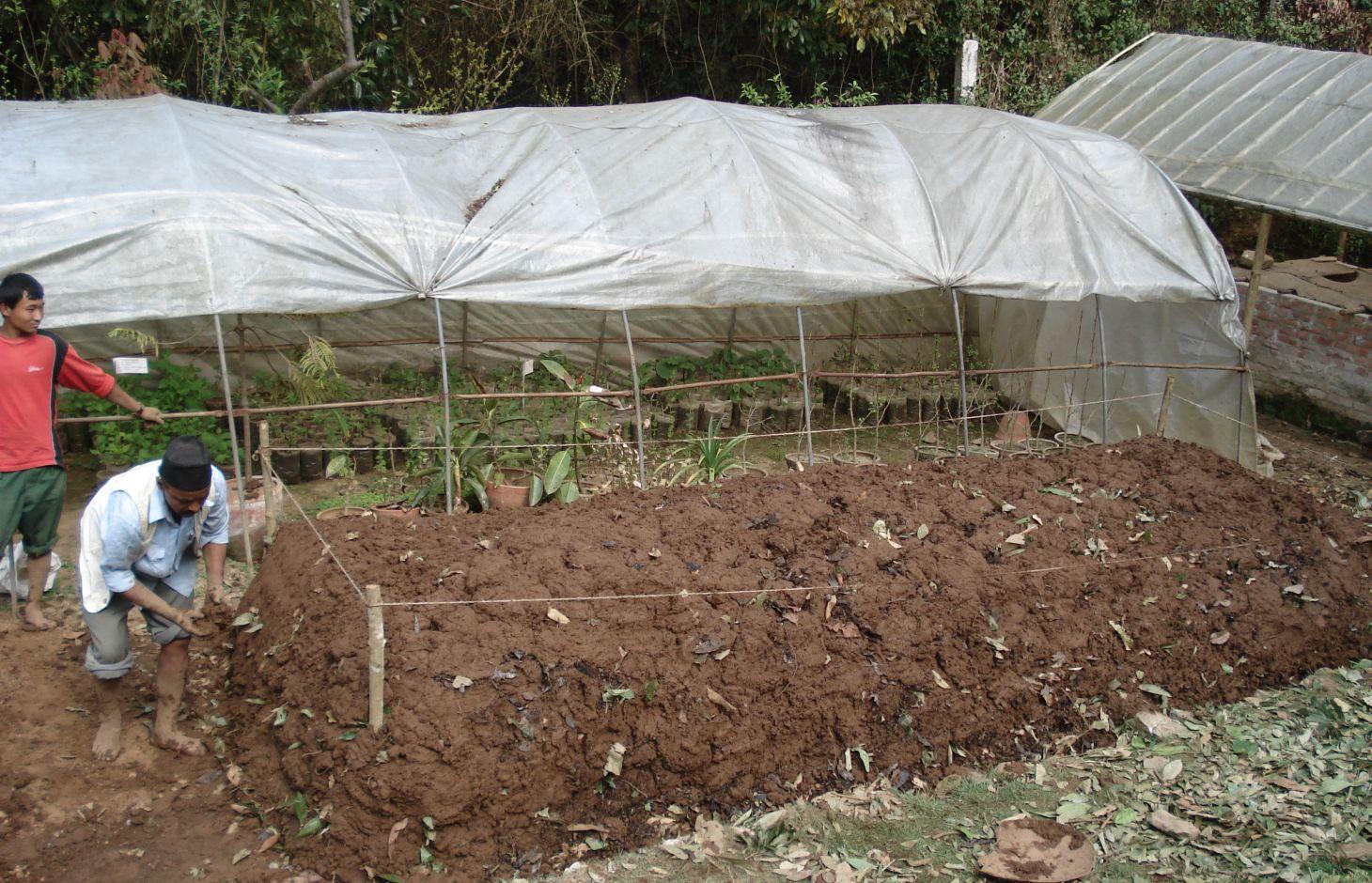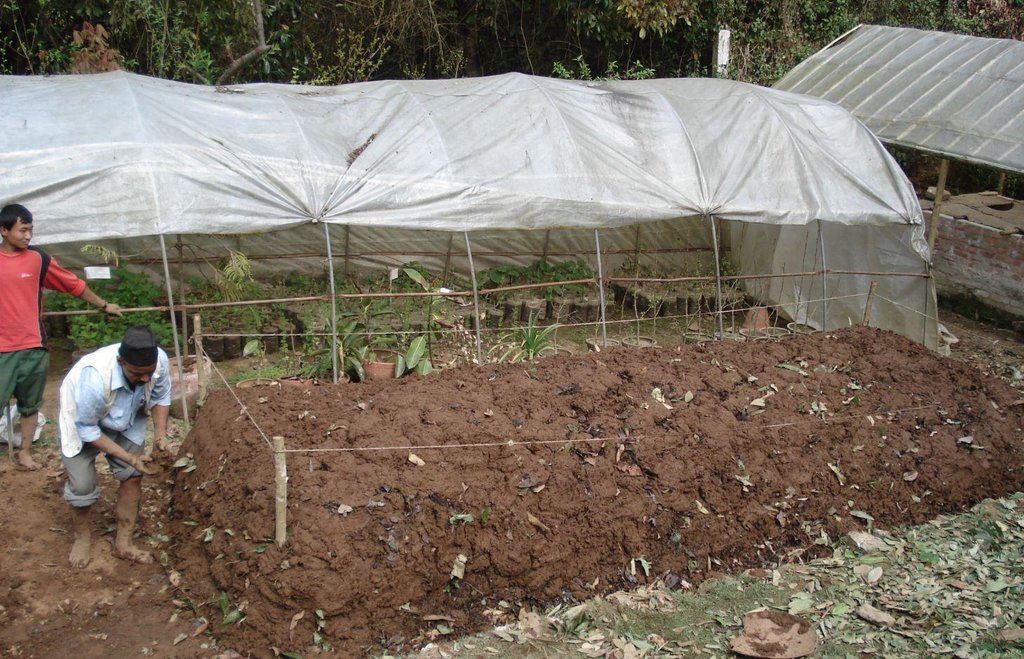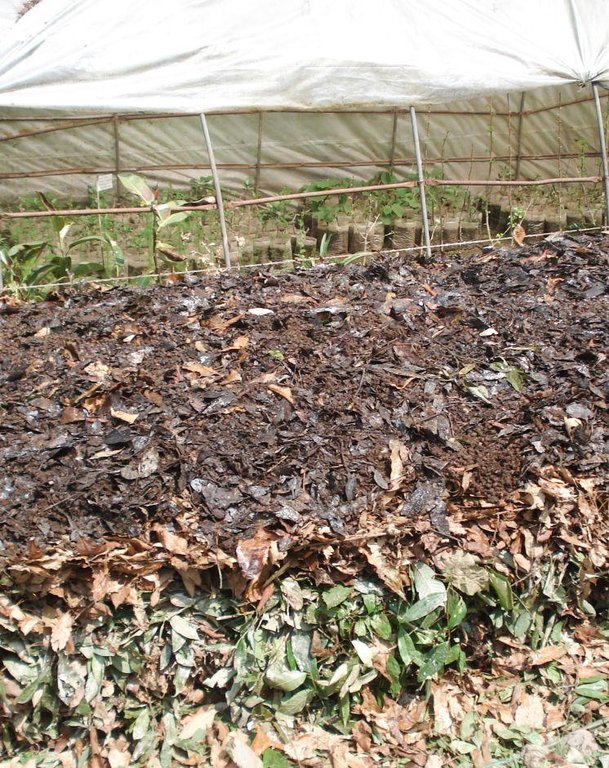Biodynamic composting [Népal]
- Création :
- Mise à jour :
- Compilateur : Shreedip Sigdel
- Rédacteur : –
- Examinateurs : David Streiff, Alexandra Gavilano
Jaibic Mal Banune Takika (Nepali) (Main Contributor: Samden Sherpa, ICIMOD)
technologies_1682 - Népal
Voir les sections
Développer tout Réduire tout1. Informations générales
1.2 Coordonnées des personnes-ressources et des institutions impliquées dans l'évaluation et la documentation de la Technologie
Spécialiste GDT:
Sherpa Samden L
ICIMOD
Népal
Nom du ou des institutions qui ont facilité la documentation/ l'évaluation de la Technologie (si pertinent)
ICIMOD International Centre for Integrated Mountain Development (ICIMOD) - Népal1.3 Conditions relatives à l'utilisation par WOCAT des données documentées
Le compilateur et la(les) personne(s) ressource(s) acceptent les conditions relatives à l'utilisation par WOCAT des données documentées:
Oui
2. Description de la Technologie de GDT
2.1 Courte description de la Technologie
Définition de la Technologie:
A faster and more effective way to produce high quality compost in large quantities by surface composting using dry and green farm biomass piled in a heap.
2.2 Description détaillée de la Technologie
Description:
Biodynamic denotes a method of organic farming that emphasizes a holistic understanding of the interrelationships between soil, plants, and animals in a self-sustaining system. It excludes the use of artificial chemicals and stresses the importance of integrating farm animals, the cultivation of crops, and caring for the land. Fermented herbal and mineral preparations are used as compost additives and field sprays.
Purpose of the Technology: Biodynamic composting is an inexpensive means of producing a large amount of compost within a relatively short time compared to other methods. It is ideal for farmers who require large amounts of compost, such as for orchards; or when several households get together to produce and share compost. This type of composting also helps to store soil carbon, assists irrigation practices that keep fields alternatively moist and dry, works to decrease the number of soil pests, and reduces methane emission. This practice not only enhances agricultural production as an on-site benefit to the land users but also contributes to the off-site benefits enjoyed by downstream land users, since it helps to reduce sedimentation and increases water availability.
Establishment / maintenance activities and inputs: The biodynamic compost is prepared as a surface heap rather than in a traditional pit. The heap is built on a flat, dry site away from shade trees and other elements that would promote water logging. The farmer marks out a rectangular plot of land according to his needs and places a set of logs or PVC pipes lengthwise in the middle of the rectangle to facilitate air circulation and help aerate the pile. Alternating layers of dry and green biomass are added on top. Rock phosphate and crushed slaked lime are added to the middle layers to enhance decomposition and to supplement the mineral content. Once the layering is complete, the pile is sealed using a paste made from soil and cow dung. Over the ensuing two months, the pile is watered weekly (through holes made in the plaster layer which are then resealed) and is monitored; any cracks that appear in the external plaster are sealed. At the end of this time, the compost is tested to check if it is ready by taking samples from a few different locations in the heap. When a crushed sample smells like forest soil, it indicates that the degradation is 80% complete and that the compost is ready to use.
2.3 Photos de la Technologie
2.5 Pays/ région/ lieux où la Technologie a été appliquée et qui sont couverts par cette évaluation
Pays:
Népal
Autres spécifications du lieu:
Lalitpur District
Spécifiez la diffusion de la Technologie:
- appliquée en des points spécifiques ou concentrée sur une petite surface
Commentaires:
Demonstration Plot at ICIMOD Knowledge Park
2.6 Date de mise en œuvre de la Technologie
Si l'année précise est inconnue, indiquez la date approximative: :
- il y a entre 10-50 ans
2.7 Introduction de la Technologie
Spécifiez comment la Technologie a été introduite: :
- au cours d'expérimentations / de recherches
3. Classification de la Technologie de GDT
3.1 Principal(aux) objectif(s) de la Technologie
- réduire, prévenir, restaurer les terres dégradées
- Access to fertilizer
3.2 Type(s) actuel(s) d'utilisation des terres, là où la Technologie est appliquée

Terres cultivées
- Cultures annuelles

Forêts/ bois
Produits et services:
- Bois de chauffage
- fodder
Commentaires:
Major land use problems (compiler’s opinion): Crop productivity is limited by poor soil fertility, intense cropping, and a scarcity of irrigation water. Farmers in the hills notice a marked decrease in the health of their crops and degraded soil conditions when chemical fertilizers are overused. Biodynamic composting is a low input response to this problem.
Forest products and services: fuelwood
Other forest products and services: fodder
Constraints of Scrubland
3.5 Groupe de GDT auquel appartient la Technologie
- gestion intégrée de la fertilité des sols
3.6 Mesures de GDT constituant la Technologie

modes de gestion
- M5: Contrôle/ changement de la composition des espèces
3.7 Principaux types de dégradation des terres traités par la Technologie

dégradation chimique des sols
- Cn: baisse de la fertilité des sols et réduction du niveau de matière organique (non causée par l’érosion)
3.8 Prévention, réduction de la dégradation ou réhabilitation des terres dégradées
Spécifiez l'objectif de la Technologie au regard de la dégradation des terres:
- prévenir la dégradation des terres
4. Spécifications techniques, activités, intrants et coûts de mise en œuvre
4.1 Dessin technique de la Technologie
Spécifications techniques (associées au dessin technique):
Layering of the different materials in a biodynamic compost heap
Technical knowledge required for field staff / advisors: moderate
Technical knowledge required for land users: moderate (technicians as well)
Main technical functions: increase in organic matter, Increase Soil fertility and Productivity, Improve Physical condition of the soil
Secondary technical functions: increase of infiltration, increase / maintain water stored in soil, Improve the physical properties of the soil
Other type of management: Improve Compost Quality
Auteur:
Layering of the different materials in a biodynamic compost heap
4.2 Informations générales sur le calcul des intrants et des coûts
Spécifiez la manière dont les coûts et les intrants ont été calculés:
- par entité de la Technologie
Précisez l'unité:
compost heap
autre/ monnaie nationale (précisez):
NPR
Indiquez le taux de change des USD en devise locale, le cas échéant (p.ex. 1 USD = 79.9 réal brésilien): 1 USD = :
71,0
4.3 Activités de mise en place/ d'établissement
| Activité | Calendrier des activités (saisonnier) | |
|---|---|---|
| 1. | include cow dung, crushed lime, rock phosphate (or bone meal), and dry and green farm matter. The compost heap is assembled in less than one day and the compost is ready to use within two months (under weather and temperature conditions similar to those at the ICIMOD Knowledge Park).Note: If rock phosphate is not available, crushed stone dust can besubstituted. | 2 month |
4.4 Coûts et intrants nécessaires à la mise en place
| Spécifiez les intrants | Unité | Quantité | Coûts par unité | Coût total par intrant | % du coût supporté par les exploitants des terres | |
|---|---|---|---|---|---|---|
| Main d'œuvre | Labour | unit | 1,0 | 80,0 | 80,0 | |
| Equipements | Shovel, chopping machine, bucket, bamboo, rope | unit | 1,0 | 20,0 | 20,0 | |
| Matériaux de construction | cow dung | kg/unit | 300,0 | 0,1 | 30,0 | |
| Matériaux de construction | lime and rock phosphate | kg/unit | 25,0 | 0,8 | 20,0 | |
| Coût total de mise en place de la Technologie | 150,0 | |||||
| Coût total de mise en place de la Technologie en dollars américains (USD) | 2,11 | |||||
4.5 Activités d'entretien/ récurrentes
| Activité | Calendrier/ fréquence | |
|---|---|---|
| 1. | The compost heap is punctured weekly in order to add water; after watering, the punctures are resealed using cow dung. | weekly |
4.6 Coûts et intrants nécessaires aux activités d'entretien/ récurrentes (par an)
| Spécifiez les intrants | Unité | Quantité | Coûts par unité | Coût total par intrant | % du coût supporté par les exploitants des terres | |
|---|---|---|---|---|---|---|
| Main d'œuvre | Labour | unit | 1,0 | 25,0 | 25,0 | |
| Matériaux de construction | Compost / manure | unit | 1,0 | 10,0 | 10,0 | |
| Coût total d'entretien de la Technologie | 35,0 | |||||
| Coût total d'entretien de la Technologie en dollars américains (USD) | 0,49 | |||||
4.7 Facteurs les plus importants affectant les coûts
Décrivez les facteurs les plus importants affectant les coûts :
All costs and amounts are rough estimates by the technicians and authors. Exchange rate USD 1 = NPR 71 in May 2011. This was a demonstration project conducted by ICIMOD.
5. Environnement naturel et humain
5.1 Climat
Précipitations annuelles
- < 250 mm
- 251-500 mm
- 501-750 mm
- 751-1000 mm
- 1001-1500 mm
- 1501-2000 mm
- 2001-3000 mm
- 3001-4000 mm
- > 4000 mm
Zone agro-climatique
- subhumide
Thermal climate class: temperate
5.2 Topographie
Pentes moyennes:
- plat (0-2 %)
- faible (3-5%)
- modéré (6-10%)
- onduleux (11-15%)
- vallonné (16-30%)
- raide (31-60%)
- très raide (>60%)
Reliefs:
- plateaux/ plaines
- crêtes
- flancs/ pentes de montagne
- flancs/ pentes de colline
- piémonts/ glacis (bas de pente)
- fonds de vallée/bas-fonds
Zones altitudinales:
- 0-100 m
- 101-500 m
- 501-1000 m
- 1001-1500 m
- 1501-2000 m
- 2001-2500 m
- 2501-3000 m
- 3001-4000 m
- > 4000 m
5.3 Sols
Profondeur moyenne du sol:
- très superficiel (0-20 cm)
- superficiel (21-50 cm)
- modérément profond (51-80 cm)
- profond (81-120 cm)
- très profond (>120 cm)
Texture du sol (de la couche arable):
- moyen (limoneux)
Matière organique de la couche arable:
- abondant (>3%)
Si disponible, joignez une description complète du sol ou précisez les informations disponibles, par ex., type de sol, pH/ acidité du sol, capacité d'échange cationique, azote, salinité, etc.
Soil fertility is medium
Soil drainage / infiltration is poor
Soil water storage capacity is medium
5.4 Disponibilité et qualité de l'eau
Profondeur estimée de l’eau dans le sol:
< 5 m
Disponibilité de l’eau de surface:
bonne
Qualité de l’eau (non traitée):
uniquement pour usage agricole (irrigation)
Commentaires et précisions supplémentaires sur la qualité et la quantité d'eau:
Water quality (untreated): Also good drinking water
5.5 Biodiversité
Diversité des espèces:
- élevé
Commentaires et précisions supplémentaires sur la biodiversité:
695 species of flora and 230 species of fauna have been documented within the Park's 30 ha area
5.6 Caractéristiques des exploitants des terres appliquant la Technologie
Orientation du système de production:
- exploitation mixte (de subsistance/ commerciale)
Revenus hors exploitation:
- > 50% de tous les revenus
Niveau relatif de richesse:
- pauvre
Individus ou groupes:
- employé (entreprise, gouvernement)
Niveau de mécanisation:
- travail manuel
- traction animale
Genre:
- femmes
- hommes
Indiquez toute autre caractéristique pertinente des exploitants des terres:
Land users applying the Technology are mainly common / average land users
Population density: < 10 persons/km2
(Neighbouring communities are poor).
Off-farm income specification: >50% of all households around the demonstration site have off-farm income
Market orientation of production system: In the vicinity of the demonstration site
5.7 Superficie moyenne des terres utilisées par les exploitants des terres appliquant la Technologie
- < 0,5 ha
- 0,5-1 ha
- 1-2 ha
- 2-5 ha
- 5-15 ha
- 15-50 ha
- 50-100 ha
- 100-500 ha
- 500-1 000 ha
- 1 000-10 000 ha
- > 10 000 ha
Cette superficie est-elle considérée comme de petite, moyenne ou grande dimension (en se référant au contexte local)?
- petite dimension
5.8 Propriété foncière, droits d’utilisation des terres et de l'eau
- government
Droits d’utilisation des terres:
- communautaire (organisé)
Droits d’utilisation de l’eau:
- communautaire (organisé)
5.9 Accès aux services et aux infrastructures
routes et transports:
- pauvre
- modéré
- bonne
labour available:
- pauvre
- modéré
- bonne
6. Impacts et conclusions
6.1 Impacts sur site que la Technologie a montrés
Impacts socio-économiques
Production
production agricole
Revenus et coûts
dépenses pour les intrants agricoles
Commentaires/ spécifiez:
Reduce expenses for purchasing chemical fertilizers
revenus agricoles
Impacts socioculturels
connaissances sur la GDT/ dégradation des terres
Commentaires/ spécifiez:
Improve knowledge on bio dynamic composting
Improve knowledge on soil conservation and soil fertility
livelihood and human well-being
Commentaires/ spécifiez:
Biodynamic composting is an advanced farming system that is gaining popularity because it improves the quality of crops and the health of the soil. The use of biodynamic compost improves soil fertility; increases agricultural production, and contributes to improved livelihoods.
Impacts écologiques
Sols
matière organique du sol/ au dessous du sol C
Autres impacts écologiques
Better compost encourages farmers to diversify crops to include mixed farming
Use of chemical fertilizers
6.2 Impacts hors site que la Technologie a montrés
Environmentally friendly: keeps village cleaner by recycling waste matter
6.4 Analyse coûts-bénéfices
Quels sont les bénéfices comparativement aux coûts de mise en place (du point de vue des exploitants des terres)?
Rentabilité à court terme:
positive
Rentabilité à long terme:
positive
Quels sont les bénéfices comparativement aux coûts d'entretien récurrents (du point de vue des exploitants des terres)?
Rentabilité à court terme:
positive
Rentabilité à long terme:
positive
Commentaires:
The land user enjoys both short and long-term benefits; in the short term there is a reduced need for costly chemical/mineral fertilizers and in the long term the health of the soil improves. Locally available dry and green biomass can be used for making biodynamic compost. The only extra costs arise from the need for lime, rock phosphate, and labour.
6.5 Adoption de la Technologie
- cas isolés/ expérimentaux
Si disponible, quantifiez (nombre de ménages et/ou superficie couverte):
Experiment
De tous ceux qui ont adopté la Technologie, combien d'entre eux l'ont fait spontanément, à savoir sans recevoir aucune incitation matérielle, ou aucune rémunération? :
- 0-10%
Commentaires:
There is a moderate trend towards spontaneous adoption of the Technology
Comments on adoption trend: The biodynamic composting technique found a high rate of acceptance with orchard and vegetable farmers. ICIMOD provided farmers from the Godavari and Bishankhunarayan Village Development Committee areas with training on biodynamic composting. The farmers who need a large amount of compost, such as those who have orchards, have adopted the technique and are now producing the compost themselves.
Drivers for adoption:
• The technology is simple and inexpensive; it can be implemented using local materials.
• The biodynamic method is faster and produces more compost than traditional methods.
• The conditions promote complete decomposition and help to reduce the incidence of soil pests.
Constraints
• There is some initial investment cost in terms of the labour needed to collect biomass/soil and to construct the heap.
• This composting method is limited to farmers who keep livestock because fresh cow dung is needed.
6.7 Points forts/ avantages/ possibilités de la Technologie
| Points forts/ avantages/ possibilités du point de vue du compilateur ou d'une autre personne ressource clé |
|---|
|
The main advantage of this method is that the composting process is completed within 60 days, whereas the traditional method requires more than 120 days. The biodynamic compost itself is very fine and decomposition takes place uniformly from top to bottom in the heap. How can they be sustained / enhanced? Share experiences with a wider audience and provide training to replicate the technology. |
|
The quality of biodynamic compost is better than that of traditionally prepared compost. The nutrient content of N, P, K, and organic matter, and the C/N ratio, are higher How can they be sustained / enhanced? Share experiences with a wider audience and provide training to replicate the technology. |
|
This method is suitable for producing large amounts of compost How can they be sustained / enhanced? As above |
|
Promotes organic production of desired crops and avoids the need for chemical fertilizers How can they be sustained / enhanced? As above |
6.8 Faiblesses/ inconvénients/ risques de la Technologie et moyens de les surmonter
| Faiblesses/ inconvénients/ risques du point de vue du compilateur ou d'une autre personne ressource clé | Comment peuvent-ils être surmontés? |
|---|---|
| Large amounts of biomass are not always available | Rice and wheat straw can also be used if forest biomass is not easily available. |
| Rock phosphate is not always available | crushed stone dust can be substituted. |
7. Références et liens
7.1 Méthodes/ sources d'information
7.2 Références des publications disponibles
Titre, auteur, année, ISBN:
Biodynamic farming and compost preparation, Diver, S, 1999
Liens et modules
Développer tout Réduire toutLiens
Aucun lien
Modules
Aucun module trouvé





